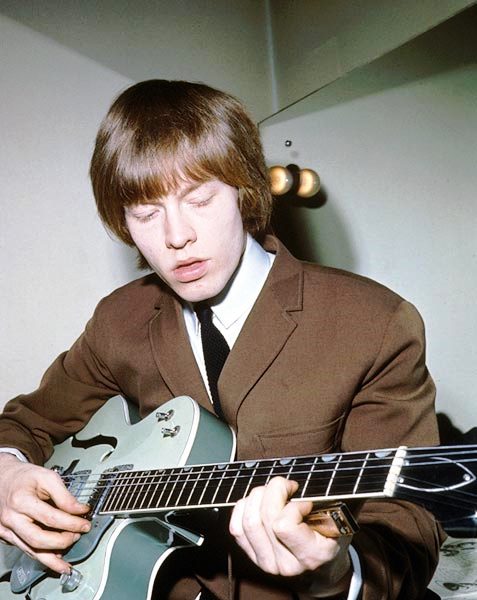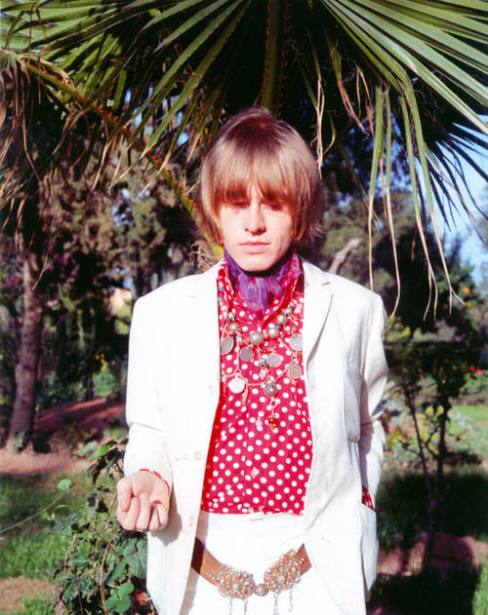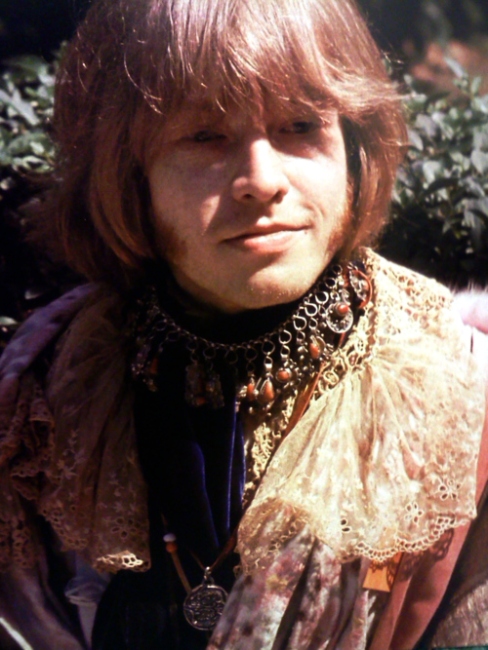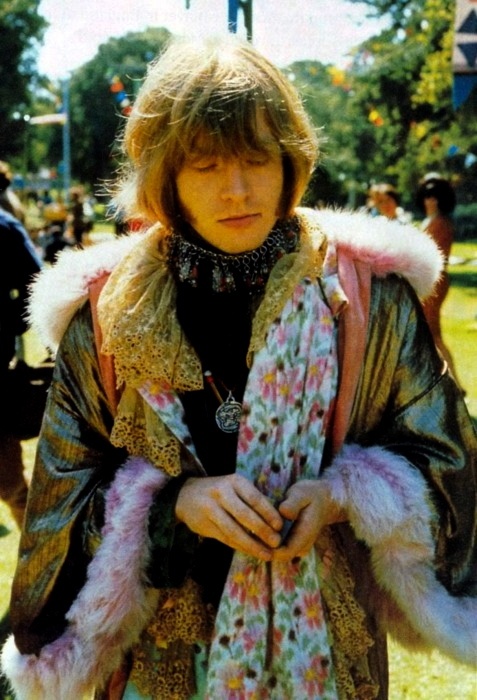![Twiggy & Justin]()
Twiggy & Justin de Villeneuve
.
For a while now I’ve been curious about ‘what happened to Justin de Villeneuve, after he and Twiggy split up as a couple and professionally’, so it was time to find out more about him. And I’m happy I did, because it’s the story of a chameleon and a one of a kind, who reinvented himself more often than Madonna did……, being a boxer, a colourful villain, a hairdresser, interior decorator, manager, photographer and poet, but best known for launching Twiggy’s modeling career and making her a superstar.
.
Short Biography
![Twiggy & Justin]()
Born Nigel Jonathan Davies in East End London, 1939. But Nigel didn’t seem a great name for a boy with ambitions, so he starts calling himself Nagels. Everyone, he says, with their fingers in dodgy pies, knew Nagels. He was one of the most persuasive mouths around, learning his craft by encouraging punters into strip clubs in Soho. From there he turned a few folding ones as the plant in the audience who volunteers to fight the boxer in the fairground ring and soon he was buying and selling this and that. Once he got his hands on a job lot of wine.
“It was an insurance job, Jewish lightning struck the warehouse,” he remembers. “The wine tasted like paint-stripper, but I just stuck fancy labels on it, and sold the lot to Vidal Sassoon for his wedding. He invited me along, I was very nervous, positioned myself by the door to do a runner. But they were such gullibles, his guests, they got conned by the labels, everyone loved it. Vidal was so impressed, he made me his assistant.”
It was then, as number two to the fanciest snipper in town, that the young fast-lip decided that a false name was required to complete the con. This time he renamed himself Christian St Forget. But not for long. “I’d heard the name Justin and I liked it. Then someone said I should choose a French second name, but I didn’t know any. So they said, ‘Well just take the name of a town.’ So I said, ‘What, like Harlow New Town?’ And that was it: Villeneuve.” And so, suitably titled, the young hairdresser soon found himself blagging his way into the affections of all sorts of handsome women who came in to have their hair done. One was a skinny 15-year-old called Lesley Hornby.
![Justin & Twiggy]()
She attracts the attentions of de Villeneuve, ten years her senior, while working as a Saturday girl in the local hairdressing salon. “I started going out with Lesley in 1965″. She wanted to become a model and Justin changes her name to Twiggy. Together they arranged meetings with fashion editors, but they all said she looked too young. He sets about promoting her look with great success. Eventually she got her break, within six months of meeting, Twiggy was on the front cover of every magazine. She is declared ‘the face of 1966′ by the Daily Express. Twiggy is photographed by Vogue, flown to New York, and becomes a recognisable fashion icon throughout the world.
“A lot of tap dancing went on,” he says. “I didn’t know what I was doing, I had a lot of front, but I had a lot of taste as well. I’d only let her do the good stuff. We exploded, we were like the biggest names. It was Mick and Keith, John and Paul, and Justin and Twigs. At one point I got through 23 cars in 12 months, Ferraris the lot. I had a domestic staff, five of them: cook, butler, chauffeur. Ridiculous, but I don’t regret a minute of it.”
![NYC4904]()
![dc5ccc659abb12a82cbc1784555099d5]()
![tumblr_m8mhtp0LXg1r9lhfqo1_500]()
It occurred in the early Seventies, when the pair had been an item for eight years, during preparation for the follow-up to the film The Boy Friend (“You remember, lovely film, really made Twigs”). De Villeneuve blames it all on a contractual problem. A script had been arranged, a producer engaged, Fred Astaire was going to star alongside Twiggy and a semi-famous actor was lined up to play the love interest. But then the snag struck: the money couldn’t be agreed on, and he dropped out. So an actor called Michael Whitney was recruited in his place. And, whoops.
“Halfway through the filming she rings and tells me she’s in love with Michael Whitney and I’ve got the old elbow. Devastated I was,” De Villeneuve remembers. “But the thing was, it need never have happened. Michael Whitney never needed to be there. It was contractual problems, you see, with the first geezer. Contractual problems which I could’ve sorted, but the agents wouldn’t let me. If only I’d been allowed to sit down with the bloke, then, well: crash, bang, wallop, two kippers and a bon-bon, how’s your father, done and dusted.” A colourful way of recalling his life has Justin de Villeneuve.
![model-twiggy-and-her-manager-boyfriend-justin-de-villeneuve-1970]()
![MV5BNzk4NTI3Mjk3MV5BMl5BanBnXkFtZTYwMTY0NDU2__V1__SX420_SY304_]()
![twigJust02739401]()
De Villeneuve takes fifty percent of her earnings as a model, and from the dress line set up in her name and the franchises for dolls and accessories. During the early relationship, Twiggy is naïve in business whilst de Villeneuve becomes increasingly extravagant – he takes delivery of a new Italian car every six weeks; Tommy Nutter suits are ordered ten at a time.
As Twiggy starts to become more aware of her earnings, De Villeneuve has difficulty demonstrating his relevance to their existing business relationship. He antagonizes professional photographers by taking up photography and then demanding grandiose fees; he generates a similar response in the film world and is deemed incapable of standing back and accepting his role should simply be that of an effective agent.
![Twiggy in Biba]()
![Twiggy in Biba]()
![twiggy-in-Biba]()
![Twiggy in Biba]()
![Twiggy in Biba]() Iconic photographs of Twiggy in Biba by Justin de Villeneuve
Iconic photographs of Twiggy in Biba by Justin de Villeneuve
![Twiggy by Justin de Villeneuve, Dudu make-up by Biba]() Twiggy in Dudu make-up advertisement for Biba by Justin de Villeneuve
Twiggy in Dudu make-up advertisement for Biba by Justin de Villeneuve
“By 1973, we were no longer a couple, but I remained her manager. David Bowie’s Aladdin Sane had just come out, and we loved the line: ‘Twig the wonder kid.’ We met Bowie a few times socially, and he mentioned that he wanted to be the first man on the cover of Vogue. I called them to suggest this, with Twiggy, of course, and after a bit of a hoo-ha, they agreed. T
o be honest, I wasn’t a professional photographer. I had watched Bert Stern, a hero of mine, do a cover with Twigs. I was fascinated by the set up: he would disappear into an office while the assistants set everything up. Then, when it was ready, he would return, utter those immortal words, “Strike a pose”, click the picture and go. I thought: “Justin, you can do that.” That’s the moment I became a photographer.
![Twiggy, Justin, Vogue]() Twiggy for Vogue by Justin de Villeneuve
Twiggy for Vogue by Justin de Villeneuve
![Twiggy, 1971. Picture by Justin de Villeneuve]() Twiggy, 1971. Picture by Justin de Villeneuve
Twiggy, 1971. Picture by Justin de Villeneuve
![Twiggy, justin, vogue italia]() Twiggy for Italian Vogue by Justin de Villeneuve
Twiggy for Italian Vogue by Justin de Villeneuve
Bowie was working on Pin Ups in Paris, so we flew there to do the shoot. When Twigs and Bowie were together and lit up, I looked through the viewfinder and realised that David was pure white, whereas Twiggy was tanned from a holiday in Bermuda. There was a moment of panic because I knew it would look bizarre; but the makeup artist suggested drawing masks on them, and this worked out even better.
I remember distinctly that I’d got it with the first shot. It was too good to be true. When I showed Bowie the test Polaroids, he asked if he could use it for the Pin Ups record sleeve. I said: “I don’t think so, since this is for Vogue. How many albums do you think you will sell?” “A million,” he replied. “This is your next album cover!” I said. When I got back to London and told Vogue, they never spoke to me again. Several weeks later, Twigs and I were driving along Sunset Boulevard and we passed a 60ft billboard of the picture. I knew I had made the right decision.”
![Twiggy and David Bowie]()
Photo of twiggy & David Bowie, commissioned by Vogue, but ends up as album cover for 'Pin Ups'
.
In 1973, Twiggy severs her ties with de Villeneuve. And with that out went his main source of income. For a few years, De Villeneuve traded on the old name, doing a bit of interior decorating here (“Some poor sap in the City gave me a grand for doing out their restaurant; I hadn’t a clue”), a bit of pop management there (two of his clients were Tim Hardin and – we all make mistakes – Clifford T Ward). But it was not enough to sustain the domestics.
“I was used to picking up the phone and making it work,” he says. “All of a sudden you’ve got receptionists saying, ‘How do you spell that name?’ “
Then, in the middle of a very barren run in the Eighties, came a crushing revelation. “I realised that I was only any good at that sort of thing when I was with Twigs,” he says. “It became an enormous handicap, my name. You could feel people assuming everything I did must be a load of old bollocks. People seemed to take enormous pleasure in my fall.” Moreover, by then, Twiggy wasn’t around to help him make a few quid. All this self-assessment, though, had a positive outcome. De Villeneuve decided to write about the good times in book form (An Affectionate Punch, published in 1986).
http://www.amazon.co.uk/An-Affectionate-Punch-Justin-Villeneuve/dp/0283993464
.
.
1975 Justin weds American Model Jan Ward. Together they have to baby girls, who now have made a name for themselves in fashion styling, Poppy de Villeneuve and illustration, Daisy de Villeneuve.
![510037491-378x505]() Jan (Ward) & Justin de Villeneuve
Jan (Ward) & Justin de Villeneuve
.
Another marvelous scheme
Justin worked as a studio producer for a while, after his split from Twiggy. You can find an entertaining story about this when you click on the next link!!!
http://www.studiowner.com/essays/essay.asp?books=0&pagnum=123
.
2007 Justin married Sue Timney, president of the British Institute of Interior Design, at Chelsea Town Hall, they live in Kent
![jones_56]()
Justin de Villeneuve & Sue Timney
.
Now retired, Justin’s influence on Twiggy’s career was again highlighted when Bonhams auctioned the iconic photograph by Barry Lategan from her first modelling shoot in 1966. It had been arranged by de Villeneuve. The picture, which fetched £5,600, propelled Twiggy to international stardom.
.
Exhibition in 2011
.
FACES OF THE SIXTIES: Justin de Villeneuve With a portfolio full of celebrated fashion shots and iconic portrait sittings with a number superstars of his era and glossy magazine publications, the new exhibition in Proud Chelsea is a marvellous look back at a prolific career. Featuring Twiggy, Pattie Boyd, Marsha Hunt and David Bowie, this exhibition showcases an exclusive collection of de Villeneuve’s rare and unseen photographs. Not only his famous sitters, but de Villeneuve himself is one of the most intriguing characters in British fashion history.
.
![???????????]() A beauty shot of Twiggy for Biba’s new range of cosmetics, 1970
A beauty shot of Twiggy for Biba’s new range of cosmetics, 1970
![???????????]() American singer and novelist Marsha Hunt at the time of her appearance in the stage musical ‘Hair’, 1968
American singer and novelist Marsha Hunt at the time of her appearance in the stage musical ‘Hair’, 1968
![5133174310]() Twiggy wearing a fur-trimmed dress knitted by herself, over a white blouse, 1972
Twiggy wearing a fur-trimmed dress knitted by herself, over a white blouse, 1972
![???????????]() Twiggy & Patti Boyd for Italian Vogue, 1970
Twiggy & Patti Boyd for Italian Vogue, 1970
![56013784_10]() Twiggy & Patti Boyd for Italian Vogue, 1970
Twiggy & Patti Boyd for Italian Vogue, 1970
![???????????]() Twiggy wearing a peasant-style dress in a promotional shot for Ken Russell’s ‘The Boy Friend’
Twiggy wearing a peasant-style dress in a promotional shot for Ken Russell’s ‘The Boy Friend’
![article-2282392-182E5B77000005DC-768_634x591]() Twiggy wearing an Ossie Clark fox fur coat from 1970
Twiggy wearing an Ossie Clark fox fur coat from 1970
![Twiggy by justin de villeneuve]()
.
Book
![51td-3uKWIL__SY344_BO1,204,203,200_]()
http://www.amazon.com/Twiggy-Justin-Thomas-Whiteside/dp/B0006BUYPO
.
![Justin_de_Villeneuve_700]() Justin de Villleneuve, 2006
.
Justin de Villleneuve, 2006
.
Information for this post: Interview by Jim White, 1995
http://www.independent.co.uk/arts-entertainment/books/no-more-mr-twiggy-1603492.html
Filed under:
biography ![]()
![]()











































































































































































































































































































































































































































































































































































































